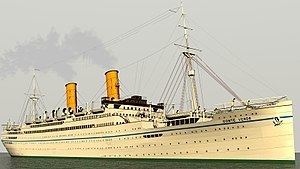Name SS Conte Verde Maiden voyage April 21, 1923 Length 180 m | Launched 21 October 1922 | |
 | ||
Operator 1925-1932 Lloyd Sabaudo1932-1943 Lloyd Triestino Fate Scuttled on September 8, 1943, refloated by Japanese military in 1944, and re-sunk by US air raid in July 1945. Builder William Beard and Company | ||
Conte Verde was an Italian ocean liner active in the early 20th century.
Contents
The name was chosen in honor of Amadeus VI, Count of Savoy, the so-called “Green Count.” She was launched in 1923 at the shipyard of William Beardmore and Company in Dalmuir, Scotland. The ship was a transatlantic liner of 18,761 GRT, ordered by the Italian shipping company Lloyd Sabaudo Line in Genoa. The first-class accommodations had a capacity of 450 passengers, second class was 200 passengers and third class (emigrants rooms) was 1,780 passengers. In addition, 400 crew members were on board. The ship was composed of 10 decks. The interiors of public rooms were designed in luxurious Italian classical styles. Her sister ship was the SS Conte Rosso.
Lloyd Sabaudo’s Transatlantic Line
She started her maiden voyage from Genoa to Buenos Aires on April 21, 1923. She set sail for New York on June 13, 1923. One of her most famous voyages was when she brought the national association football teams of Romania, France, Belgium and Brazil to Uruguay to participate in the 1930 FIFA World Cup. The Romanian team boarded in Genoa, the French delegation (including FIFA president Jules Rimet) boarded in Villefranche-sur-Mer, the Belgian team boarded in Barcelona, and the Brazilian team boarded in Rio de Janeiro. The trophy and three referees, Jean Langenus, Henri Christophe, and Thomas Balvay also crossed the Atlantic Ocean on the ship. Other celebrities who sailed on the Conte Verde include Fyodor Chaliapin, a Russian opera singer, Josephine Baker, an American dancer, Fosco Maraini, an Italian academic of Tibetan and Japanese studies as well as a photographer and mountaineer, and Dacia Maraini, an Italian writer. Giovanni Giotta, owner of a famous San Francisco café, the Caffe Trieste founded in 1956, was a member of the ship’s crew.
Lloyd Triestino’s Far East Line
After acquisition by Italian Line in 1932, she became a part of Lloyd Triestino (also chartered by Italian Line) for service between Trieste and Shanghai via Suez, Bombay, Colombo, Singapore and Hong Kong in 24 days. [2] For this transfer, she was thoroughly refitted. The first-, second- and third-class accommodations were reduced in capacity to 250, 170 and 220 passengers, respectively, to create wider spaces.
On September 1, 1937, she collided with NYK’s Asama Maru in an extraordinarily large typhoon in Hong Kong. She had run aground off the shores of Cape Collinson, and the Asama Maru was at the northernmost part of Chai Wan Bay. The work of refloating the Conte Verde required one month, and the Asama Maru took half a year.
From 1938 to 1940, the four Lloyd Triestino ships brought a number of Jewish refugees from Germany and Austria to Shanghai. Nazi persecution intensified especially after Kristallnacht on November 9, 1938. Then the number of the refugees increased dramatically as the ships became their lifeboats. Ultimately, 17,000 Jewish refugees came to Shanghai on the Lloyd Triestino’s ships. The refugee route via the ships was closed on June 10, 1940, when Italy joined the war. The liners’ operation was suspended indefinitely, and the Conte Verde was confined to Shanghai.
Exchange ship
In December 1941, Japan declared war on the Allies. In May 1942, Japan and the US agreed to exchange interned diplomats and other citizens, chartering three ships—Conte Verde (known as Teikyo Maru while chartered), Asama Maru and Gripsholm—for this purpose. The Conte Verde and Asama Maru were sent by Japan, and the Gripsholm by the US. They met at Lourenco Marques, exchanged the internees and returned. The Conte Verde and Asama Maru were moored at Yokohama while waiting for the second exchange voyage, but negotiations between Japan and the US collapsed. The Conte Verde left Yokohama on September and returned to Shanghai.
Sinking
Due to the Italian Armistice in 1943, Conte Verde was scuttled in Shanghai by her Italian crew to prevent seizure by Japanese forces; but the Japanese refloated the ship in July 1944. She was bombed and sunk by a B-24 of the 373rd Bomb Squadron on 8 August. The ship was raised again, repaired, renamed Kotobuki Maru, converted into a troopship, and towed to Maizuru, a port town in the north of Kyoto Prefecture, in June 1945 but hit in a raid by aircraft on July 25 and beached. She was scrapped in 1949
